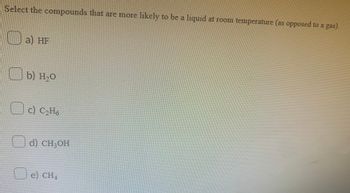
Chemistry
10th Edition
ISBN: 9781305957404
Author: Steven S. Zumdahl, Susan A. Zumdahl, Donald J. DeCoste
Publisher: Cengage Learning
expand_more
expand_more
format_list_bulleted
Question

Transcribed Image Text:Select the compounds that are more likely to be a liquid at room temperature (as opposed to a gas).
a) HF
b) H₂O
но
□ c) C₂H6
d) CH₂OH
e) CH4
Expert Solution
This question has been solved!
Explore an expertly crafted, step-by-step solution for a thorough understanding of key concepts.
This is a popular solution
Trending nowThis is a popular solution!
Step by stepSolved in 3 steps

Knowledge Booster
Learn more about
Need a deep-dive on the concept behind this application? Look no further. Learn more about this topic, chemistry and related others by exploring similar questions and additional content below.Similar questions
- 1. The phrase "Structure influences properties" is used in this course. Describe what this phrase means for you and provide at least 1 example. 2. Using the Lewis structure for each substance below, predict the hybridization for the central atom and shape of each molecule a) CF, b) PH3 c) CS2 3. The prediction of melting point rank can be useful when discussing the different applications of substances. Rank the following 4 substances from highest to lowest melting point. Include your reasoning for your rank based on intermolecular forces of attraction and support your reasoning with Lewis structures. Ammonia, NH3, Magnesium oxide, MgO, Sodium oxide, Na,0, Carbon dioxide, CO2arrow_forwardWhat are the possible intermolecular forces (IMF) that could exist in each of the following compounds (If there are more than one IMF, name them all). A. C₂H6 B. C₂H5OH C. HFarrow_forwardWhich compound is expected to exhibit the highest vapor pressure at 25°C. (A) C,H5CH3 (B) C6H5CI (C) C,H5NH2 (D) C6H5OHarrow_forward
- Need help with questionarrow_forward3 compounds are at room temperature and all have the same number of electrons. Substance A is a solid, Substance B is a liquid, and Substance C is a gas. Identify the MOST CORRECT statement. Substance A must be ionic, Substance B is polar, and Substance C is non-polar. Substance A and Substance B are polar, and Substance C just has london dispersion forces. None of the above statements are correct. The only thing that can be determined is the Substance A must be ionic. Substance A has hydrogen bonding, Substance B has dipole-dipole, and Substance C just has london dispersion forces.arrow_forwardWhich of the following substances can form hydrogen bonds? Substances: (1) CH3COCH3; (2) CH3OH; (3) C2H6; (4) HCOOH A. compounds 1 and 2 B. compounds 1 and 3 C. compounds 1, 2, and 3 D. compounds 2 and 4 E. compounds 1, 2, and 4arrow_forward
- 4. Identify which compound in each pair would have the highest boiling point (and melting point). Briefly explain each prediction based on intermolecular forces. a. O2 v Cl2 b. NH3 v PH3 c. CH4 v. C₂H6 d. NO₂ v. CO2 200arrow_forward#6arrow_forwardWhy does water have a higher boiling point and lower vapor pressure than comparably sized molecules such a s dimethyl ether (CH3-O-CH3) or N2arrow_forward
arrow_back_ios
arrow_forward_ios
Recommended textbooks for you
 ChemistryChemistryISBN:9781305957404Author:Steven S. Zumdahl, Susan A. Zumdahl, Donald J. DeCostePublisher:Cengage Learning
ChemistryChemistryISBN:9781305957404Author:Steven S. Zumdahl, Susan A. Zumdahl, Donald J. DeCostePublisher:Cengage Learning ChemistryChemistryISBN:9781259911156Author:Raymond Chang Dr., Jason Overby ProfessorPublisher:McGraw-Hill Education
ChemistryChemistryISBN:9781259911156Author:Raymond Chang Dr., Jason Overby ProfessorPublisher:McGraw-Hill Education Principles of Instrumental AnalysisChemistryISBN:9781305577213Author:Douglas A. Skoog, F. James Holler, Stanley R. CrouchPublisher:Cengage Learning
Principles of Instrumental AnalysisChemistryISBN:9781305577213Author:Douglas A. Skoog, F. James Holler, Stanley R. CrouchPublisher:Cengage Learning Organic ChemistryChemistryISBN:9780078021558Author:Janice Gorzynski Smith Dr.Publisher:McGraw-Hill Education
Organic ChemistryChemistryISBN:9780078021558Author:Janice Gorzynski Smith Dr.Publisher:McGraw-Hill Education Chemistry: Principles and ReactionsChemistryISBN:9781305079373Author:William L. Masterton, Cecile N. HurleyPublisher:Cengage Learning
Chemistry: Principles and ReactionsChemistryISBN:9781305079373Author:William L. Masterton, Cecile N. HurleyPublisher:Cengage Learning Elementary Principles of Chemical Processes, Bind...ChemistryISBN:9781118431221Author:Richard M. Felder, Ronald W. Rousseau, Lisa G. BullardPublisher:WILEY
Elementary Principles of Chemical Processes, Bind...ChemistryISBN:9781118431221Author:Richard M. Felder, Ronald W. Rousseau, Lisa G. BullardPublisher:WILEY

Chemistry
Chemistry
ISBN:9781305957404
Author:Steven S. Zumdahl, Susan A. Zumdahl, Donald J. DeCoste
Publisher:Cengage Learning

Chemistry
Chemistry
ISBN:9781259911156
Author:Raymond Chang Dr., Jason Overby Professor
Publisher:McGraw-Hill Education

Principles of Instrumental Analysis
Chemistry
ISBN:9781305577213
Author:Douglas A. Skoog, F. James Holler, Stanley R. Crouch
Publisher:Cengage Learning

Organic Chemistry
Chemistry
ISBN:9780078021558
Author:Janice Gorzynski Smith Dr.
Publisher:McGraw-Hill Education

Chemistry: Principles and Reactions
Chemistry
ISBN:9781305079373
Author:William L. Masterton, Cecile N. Hurley
Publisher:Cengage Learning

Elementary Principles of Chemical Processes, Bind...
Chemistry
ISBN:9781118431221
Author:Richard M. Felder, Ronald W. Rousseau, Lisa G. Bullard
Publisher:WILEY